+ Open data
Open data
- Basic information
Basic information
| Entry | Database: PDB / ID: 7ueb | |||||||||
|---|---|---|---|---|---|---|---|---|---|---|
| Title | Photosynthetic assembly of Chlorobaculum tepidum (RC-FMO2) | |||||||||
 Components Components |
| |||||||||
 Keywords Keywords | PHOTOSYNTHESIS / FMO / reaction center / single-particle cryo-EM / bacteriochlorophyll / electron transport chain / energy transfer | |||||||||
| Function / homology |  Function and homology information Function and homology informationthylakoid / bacteriochlorophyll binding / iron-sulfur cluster binding / photosynthesis / electron transfer activity / heme binding / metal ion binding / membrane / plasma membrane Similarity search - Function | |||||||||
| Biological species |  Chlorobaculum tepidum TLS (bacteria) Chlorobaculum tepidum TLS (bacteria) | |||||||||
| Method | ELECTRON MICROSCOPY / single particle reconstruction / cryo EM / Resolution: 3.08 Å | |||||||||
 Authors Authors | Puskar, R. / Truong, C.D. / Swain, K. / Li, S. / Cheng, K.-W. / Wang, T.Y. / Poh, Y.-P. / Liu, H. / Chou, T.-F. / Nannenga, B. / Chiu, P.-L. | |||||||||
| Funding support |  United States, 2items United States, 2items
| |||||||||
 Citation Citation |  Journal: Nat Commun / Year: 2022 Journal: Nat Commun / Year: 2022Title: Molecular asymmetry of a photosynthetic supercomplex from green sulfur bacteria. Authors: Ryan Puskar / Chloe Du Truong / Kyle Swain / Saborni Chowdhury / Ka-Yi Chan / Shan Li / Kai-Wen Cheng / Ting Yu Wang / Yu-Ping Poh / Yuval Mazor / Haijun Liu / Tsui-Fen Chou / Brent L Nannenga / Po-Lin Chiu /  Abstract: The photochemical reaction center (RC) features a dimeric architecture for charge separation across the membrane. In green sulfur bacteria (GSB), the trimeric Fenna-Matthews-Olson (FMO) complex ...The photochemical reaction center (RC) features a dimeric architecture for charge separation across the membrane. In green sulfur bacteria (GSB), the trimeric Fenna-Matthews-Olson (FMO) complex mediates the transfer of light energy from the chlorosome antenna complex to the RC. Here we determine the structure of the photosynthetic supercomplex from the GSB Chlorobaculum tepidum using single-particle cryogenic electron microscopy (cryo-EM) and identify the cytochrome c subunit (PscC), two accessory protein subunits (PscE and PscF), a second FMO trimeric complex, and a linker pigment between FMO and the RC core. The protein subunits that are assembled with the symmetric RC core generate an asymmetric photosynthetic supercomplex. One linker bacteriochlorophyll (BChl) is located in one of the two FMO-PscA interfaces, leading to differential efficiencies of the two energy transfer branches. The two FMO trimeric complexes establish two different binding interfaces with the RC cytoplasmic surface, driven by the associated accessory subunits. This structure of the GSB photosynthetic supercomplex provides mechanistic insight into the light excitation energy transfer routes and a possible evolutionary transition intermediate of the bacterial photosynthetic supercomplex from the primitive homodimeric RC. | |||||||||
| History |
|
- Structure visualization
Structure visualization
| Structure viewer | Molecule:  Molmil Molmil Jmol/JSmol Jmol/JSmol |
|---|
- Downloads & links
Downloads & links
- Download
Download
| PDBx/mmCIF format |  7ueb.cif.gz 7ueb.cif.gz | 915.9 KB | Display |  PDBx/mmCIF format PDBx/mmCIF format |
|---|---|---|---|---|
| PDB format |  pdb7ueb.ent.gz pdb7ueb.ent.gz | Display |  PDB format PDB format | |
| PDBx/mmJSON format |  7ueb.json.gz 7ueb.json.gz | Tree view |  PDBx/mmJSON format PDBx/mmJSON format | |
| Others |  Other downloads Other downloads |
-Validation report
| Summary document |  7ueb_validation.pdf.gz 7ueb_validation.pdf.gz | 5.4 MB | Display |  wwPDB validaton report wwPDB validaton report |
|---|---|---|---|---|
| Full document |  7ueb_full_validation.pdf.gz 7ueb_full_validation.pdf.gz | 5.7 MB | Display | |
| Data in XML |  7ueb_validation.xml.gz 7ueb_validation.xml.gz | 164.3 KB | Display | |
| Data in CIF |  7ueb_validation.cif.gz 7ueb_validation.cif.gz | 212.9 KB | Display | |
| Arichive directory |  https://data.pdbj.org/pub/pdb/validation_reports/ue/7ueb https://data.pdbj.org/pub/pdb/validation_reports/ue/7ueb ftp://data.pdbj.org/pub/pdb/validation_reports/ue/7ueb ftp://data.pdbj.org/pub/pdb/validation_reports/ue/7ueb | HTTPS FTP |
-Related structure data
| Related structure data |  26471MC 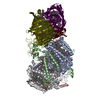 7ueaC M: map data used to model this data C: citing same article ( |
|---|---|
| Similar structure data | Similarity search - Function & homology  F&H Search F&H Search |
- Links
Links
- Assembly
Assembly
| Deposited unit | 
|
|---|---|
| 1 |
|
- Components
Components
-Photosystem P840 reaction ... , 2 types, 3 molecules AaB
| #1: Protein | Mass: 81784.641 Da / Num. of mol.: 2 / Source method: isolated from a natural source / Source: (natural)  Chlorobaculum tepidum TLS (bacteria) / Strain: ATCC 49652 / DSM 12025 / NBRC 103806 / TLS / References: UniProt: Q8KAY0 Chlorobaculum tepidum TLS (bacteria) / Strain: ATCC 49652 / DSM 12025 / NBRC 103806 / TLS / References: UniProt: Q8KAY0#2: Protein | | Mass: 23540.289 Da / Num. of mol.: 1 / Source method: isolated from a natural source / Source: (natural)  Chlorobaculum tepidum TLS (bacteria) / Strain: ATCC 49652 / DSM 12025 / NBRC 103806 / TLS / References: UniProt: Q8KAY1 Chlorobaculum tepidum TLS (bacteria) / Strain: ATCC 49652 / DSM 12025 / NBRC 103806 / TLS / References: UniProt: Q8KAY1 |
|---|
-Protein , 4 types, 5 molecules CcDEF
| #3: Protein | Mass: 22741.779 Da / Num. of mol.: 2 / Source method: isolated from a natural source / Source: (natural)  Chlorobaculum tepidum TLS (bacteria) / Strain: ATCC 49652 / DSM 12025 / NBRC 103806 / TLS / References: UniProt: O07091 Chlorobaculum tepidum TLS (bacteria) / Strain: ATCC 49652 / DSM 12025 / NBRC 103806 / TLS / References: UniProt: O07091#4: Protein | | Mass: 16633.195 Da / Num. of mol.: 1 / Source method: isolated from a natural source / Source: (natural)  Chlorobaculum tepidum TLS (bacteria) / Strain: ATCC 49652 / DSM 12025 / NBRC 103806 / TLS / References: UniProt: Q8KEP5 Chlorobaculum tepidum TLS (bacteria) / Strain: ATCC 49652 / DSM 12025 / NBRC 103806 / TLS / References: UniProt: Q8KEP5#5: Protein | | Mass: 6690.926 Da / Num. of mol.: 1 / Source method: isolated from a natural source / Source: (natural)  Chlorobaculum tepidum TLS (bacteria) / Strain: ATCC 49652 / DSM 12025 / NBRC 103806 / TLS / References: UniProt: Q8KDI3 Chlorobaculum tepidum TLS (bacteria) / Strain: ATCC 49652 / DSM 12025 / NBRC 103806 / TLS / References: UniProt: Q8KDI3#6: Protein | | Mass: 6227.533 Da / Num. of mol.: 1 / Source method: isolated from a natural source / Source: (natural)  Chlorobaculum tepidum TLS (bacteria) / Strain: ATCC 49652 / DSM 12025 / NBRC 103806 / TLS / References: UniProt: Q8KG87 Chlorobaculum tepidum TLS (bacteria) / Strain: ATCC 49652 / DSM 12025 / NBRC 103806 / TLS / References: UniProt: Q8KG87 |
|---|
-Bacteriochlorophyll ... , 1 types, 6 molecules UVWXYZ
| #7: Protein | Mass: 40343.430 Da / Num. of mol.: 6 / Source method: isolated from a natural source / Source: (natural)  Chlorobaculum tepidum TLS (bacteria) / Strain: ATCC 49652 / DSM 12025 / NBRC 103806 / TLS / References: UniProt: Q46393 Chlorobaculum tepidum TLS (bacteria) / Strain: ATCC 49652 / DSM 12025 / NBRC 103806 / TLS / References: UniProt: Q46393 |
|---|
-Non-polymers , 9 types, 106 molecules 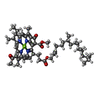
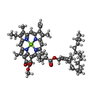
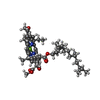
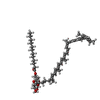













| #8: Chemical | | #9: Chemical | ChemComp-G2O / #10: Chemical | ChemComp-BCL / #11: Chemical | #12: Chemical | #13: Chemical | ChemComp-LHG / #14: Chemical | ChemComp-LMG / #15: Chemical | #16: Chemical | |
|---|
-Details
| Has ligand of interest | Y |
|---|
-Experimental details
-Experiment
| Experiment | Method: ELECTRON MICROSCOPY |
|---|---|
| EM experiment | Aggregation state: PARTICLE / 3D reconstruction method: single particle reconstruction |
- Sample preparation
Sample preparation
| Component | Name: Photosynthetic assembly (RC-FMO2) / Type: COMPLEX Details: Photosynthetic assembly from Chlorobaculum tepidum (RC-FMO2) Entity ID: #1-#7 / Source: NATURAL | ||||||||||||||||||||
|---|---|---|---|---|---|---|---|---|---|---|---|---|---|---|---|---|---|---|---|---|---|
| Molecular weight | Value: 0.504 MDa / Experimental value: NO | ||||||||||||||||||||
| Source (natural) | Organism:  Chlorobaculum tepidum TLS (bacteria) / Cellular location: Membrane Chlorobaculum tepidum TLS (bacteria) / Cellular location: Membrane | ||||||||||||||||||||
| Buffer solution | pH: 8 | ||||||||||||||||||||
| Buffer component |
| ||||||||||||||||||||
| Specimen | Conc.: 0.1 mg/ml / Embedding applied: NO / Shadowing applied: NO / Staining applied: NO / Vitrification applied: YES | ||||||||||||||||||||
| Specimen support | Grid material: COPPER / Grid type: C-flat-2/1 | ||||||||||||||||||||
| Vitrification | Instrument: HOMEMADE PLUNGER / Cryogen name: ETHANE |
- Electron microscopy imaging
Electron microscopy imaging
| Experimental equipment |  Model: Titan Krios / Image courtesy: FEI Company |
|---|---|
| Microscopy | Model: FEI TITAN KRIOS |
| Electron gun | Electron source:  FIELD EMISSION GUN / Accelerating voltage: 300 kV / Illumination mode: FLOOD BEAM FIELD EMISSION GUN / Accelerating voltage: 300 kV / Illumination mode: FLOOD BEAM |
| Electron lens | Mode: BRIGHT FIELD / Calibrated magnification: 47259 X / Nominal defocus max: 2500 nm / Nominal defocus min: 800 nm / Cs: 2.7 mm / C2 aperture diameter: 70 µm |
| Specimen holder | Cryogen: NITROGEN / Specimen holder model: FEI TITAN KRIOS AUTOGRID HOLDER |
| Image recording | Average exposure time: 6 sec. / Electron dose: 45.4 e/Å2 / Detector mode: COUNTING / Film or detector model: GATAN K2 SUMMIT (4k x 4k) / Num. of real images: 32898 |
| Image scans | Sampling size: 5 µm / Movie frames/image: 30 |
- Processing
Processing
| EM software |
| ||||||||||||||||||||||||||||||||||||||||
|---|---|---|---|---|---|---|---|---|---|---|---|---|---|---|---|---|---|---|---|---|---|---|---|---|---|---|---|---|---|---|---|---|---|---|---|---|---|---|---|---|---|
| CTF correction | Type: PHASE FLIPPING AND AMPLITUDE CORRECTION | ||||||||||||||||||||||||||||||||||||||||
| Particle selection | Num. of particles selected: 1938908 | ||||||||||||||||||||||||||||||||||||||||
| Symmetry | Point symmetry: C1 (asymmetric) | ||||||||||||||||||||||||||||||||||||||||
| 3D reconstruction | Resolution: 3.08 Å / Resolution method: FSC 0.143 CUT-OFF / Num. of particles: 157486 / Algorithm: BACK PROJECTION / Num. of class averages: 1 / Symmetry type: POINT | ||||||||||||||||||||||||||||||||||||||||
| Atomic model building | B value: 44.07 / Protocol: OTHER / Space: REAL | ||||||||||||||||||||||||||||||||||||||||
| Atomic model building | PDB-ID: 6M32 Accession code: 6M32 / Source name: PDB / Type: experimental model |
 Movie
Movie Controller
Controller




 PDBj
PDBj






















